Matsudodon: Otterly Perplexing
Posted by: Loren Coleman on April 4th, 2009
Otterly Perplexing: A Tale of Mystery Pinnipeds, Muskrats, and Otters.

In 1973, there was a brief, but prolific spate of sightings of a mysterious, seal-like creature in the Edo river of Japan.
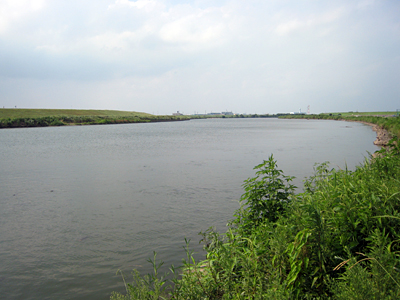
The creature was described as being around 2 meters long and resembling a seal, only with longer limbs and more pronounced claws. The animal was said to have a certain cat-like appearance to its facial features, and witnesses described the animal as being like a “cat that looked like a seal,” more than the other way around. It was even reported to make a sound like a yowling cat.
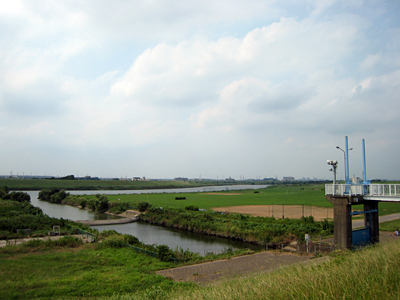
The creature was first sighted near a floodgate located along the Edo River near Matsudo, in Chiba prefecture, Japan, which is directly adjacent to Tokyo. Since the first sighting, the mysterious creature was spotted on many occasions by joggers and anglers along the riverside in the same general area. In all, eventually over 100 witnesses are said to have sighted the creature during a fairly short period in 1973. The animal became known as the “Matsudodon,” named after nearby Matsudo city, and it sparked a lot of speculation over what it could possibly be.
The most rational answer seems to be that a seal had somehow found its way up the river from the sea. This has happened before in Japan, most notably in the famous case of the seal that made its home for a time in the Tama River of Tokyo. “Tama-chan,” as the seal was affectionately known, became big news in Japan, grew to be somewhat of a celebrity, and drew large crowds of people trying to get a look at it. There have also been well publicized incidents of whales doing the very same thing. However, the cat-like appearance and sounds the Matsudodon was reported to make, as well as the longer limbs, don’t really fit in with seals or whales, and witnesses specifically insisted that what they had seen was no normal seal.
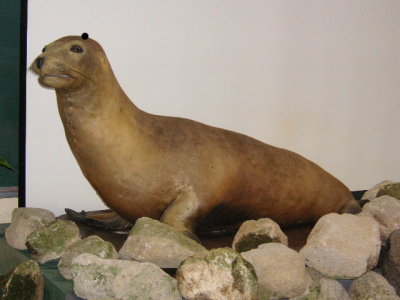
One of the last known taxidermy specimens of Zalophus japonicus. (Read more insights about the Japanese sea lion from Brent Swancer, here.)
Eventually, the list of possible culprits expanded. The possibility of very large grass carp was suggested, but again, this fish has very little in common with what was described in reports. Experts who were consulted and didn’t scoff at the accounts suggested that the creature in question was an out of place muskrat or otter, or even otters swimming in a line. No, I am not making this up.

Perhaps, this is actually an interesting idea in some respects. An otter or muskrat would not be expected in this river and could surprise people, and their appearance could possibly produce some descriptions of the Matsudodon. Do otters or muskrats sound like a cat? No they do not.
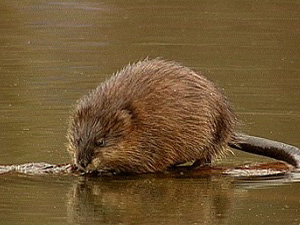
However, I recognize that when hearing a strange animal make a noise, one might be inclined to liken the sound to something more familiar. Since the Matsudodon was described as having a cat-like face, it seems possible that the sounds it made would be reported as “cat sounds,” I suppose. Neither otters nor muskrats approach 2 meters in length, but sizes could have been misjudged. And hey, they could have been swimming in a line.
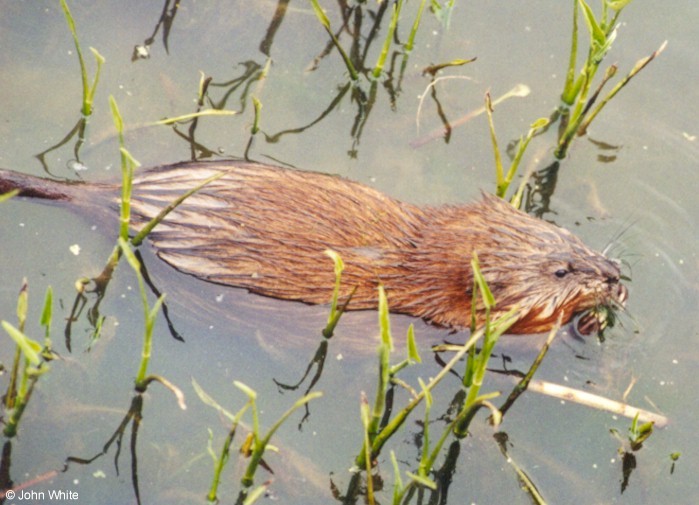
Since the sightings of the mystery creature stopped as suddenly as they began, there are only the original reports to go on and it seems that whatever the Matsudodon was, it was a one-off phenomenon. It is fairly obvious that whatever was seen in 1973, it was not a permanent resident of the area. Matsudo and its surrounding area is well developed, with several bridges spanning the Edo River that see a good amount of traffic. There are also many joggers, anglers, and people having picnics in this area, so any large creature living in the river would have undoubtedly been seen again by now. The Matsudodon must have travelled there from somewhere else. What I am curious about is from where, and just exactly what exactly it was.
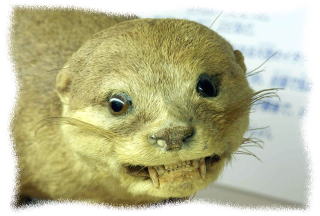
The Japanese river otter (Lutra nippon).
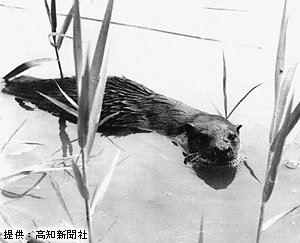
Interestingly, the Japanese River Otter is thought by some in cryptozoological circles here in Japan to be an explanation behind the sightings of another (an – otter?) Japanese cryptid, the legendary Kappa.
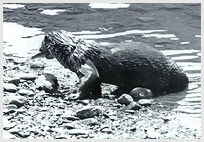
An otter view of the Japanese river otter (also Lutra lutra whiteleyi; Japanese: 日本獺, 日本川獺 nihonkawauso or nipponkawauso).
Maybe Matsudodon could be chalked up to some kind of mass hysteria. So a muskrat, otter, or a wayward seal or whale. Case closed, right?
Or is it?
At an exhibition at the Kawasaki City Museum entitled “Japan’s Mythical Creatures- Accounts of Unidentified Organisms,” there was a curious old account from 1834 concerning a strange animal in the same basic vicinity as the Matsudodon sighting flap of 1973. This 1834 account tells of 12 samurai who were killed by a vicious, seal-like monster as they were digging a canal near the Inba Marsh in Chiba prefecture, Japan. The creature was described as being 5 meters long, and looking like a large seal with a face like a monkey.
Note that the Inba Marsh is located in Chiba prefecture, which is where the area of the 1973 sightings is also located. Although the Matsudodon was not reported to be aggressive or 5 meters long, it was still large at 2 meters, and two different such strange occurrences of an apparent mystery pinniped from the same general area have me curious. Is there a connection between the creature from the 1834 report and the accounts of 1973? Is it possible that the Matsudodon of 1973 was a juvenile or different gender of whatever species allegedly killed those samurai in 1834? What sort of seal-like creature would attack and kill 12 samurai, anyway?
I find myself wondering whether there could be an unknown sea creature that is occasionally making its way up the rivers of Japan. Is it possible that the creatures seen in both cases were not just regular seals, but some sort of unknown pinniped that got trapped in the river just as known species of seal have been known to do?
Whatever these creatures were, and whether or not they are connected in any way, it is an interesting case.
=====
##############
Your contributions to the research is greatly appreciated. Only $90 has been received in the last three weeks. Even your $10 donation assists in conjunction with that from others. Thank you.
Thank you!
About Loren Coleman
Loren Coleman is one of the world’s leading cryptozoologists, some say “the” leading living cryptozoologist. Certainly, he is acknowledged as the current living American researcher and writer who has most popularized cryptozoology in the late 20th and early 21st centuries.
Starting his fieldwork and investigations in 1960, after traveling and trekking extensively in pursuit of cryptozoological mysteries, Coleman began writing to share his experiences in 1969. An honorary member of Ivan T. Sanderson’s Society for the Investigation of the Unexplained in the 1970s, Coleman has been bestowed with similar honorary memberships of the North Idaho College Cryptozoology Club in 1983, and in subsequent years, that of the British Columbia Scientific Cryptozoology Club, CryptoSafari International, and other international organizations. He was also a Life Member and Benefactor of the International Society of Cryptozoology (now-defunct).
Loren Coleman’s daily blog, as a member of the Cryptomundo Team, served as an ongoing avenue of communication for the ever-growing body of cryptozoo news from 2005 through 2013. He returned as an infrequent contributor beginning Halloween week of 2015.
Coleman is the founder in 2003, and current director of the International Cryptozoology Museum in Portland, Maine.










Actually there are otters that approach two meters in length – the giant otters of South America. Sea otters also get pretty big. I’m not suggesting that these animals in Japan are South American giant otters, but maybe there is an undiscovered species of Asiatic giant otter. According to Otters: Ecology, Behaviour, and Conservation by Hans Kruuk, giant otters originated in Asia and migrated to the New World. Of course, giant otters became extinct in Asia in prehistoric times.
I’ve seen a group of otters swimming in a line and they look remarkably like some of the traditional depictions of sea serpents. Maybe otters are the animals behind some of the lake monster and sea serpent legends.
Here’s some more information about giant otters.
Very interesting and my suspicion would rest on the sea otter. I say this for a couple of reasons, one being that its solitary appearance is typical of how adult males break away from their otherwise colonial lifestyle as they scout for new territory. I know of one area in the North Pacific where colonies of sea otters were common just outside one very extensive and seemingly ideal habitat in a large fjord system but only occasional and sporadic reports of individuals being spotted until, after several years, an entire colony of 50 or so arrived in a prime habitat miles from the fjord’s entrance, as if they were there all along.
While kayaking with a small group on a lazy sunny morning, just drifting along a shoal and watching the sealife through the clear water moving about in the shallows below us, we started to hear a kind of “mewing” and noticed that all around us were otters, probably 50 or more, in some kind of social chorus, enjoying the sun just like we were, and undoubtedly the abundant tanner-crab, chiton and urchin. We eventually drifted out of their presence and went on to explore other areas of the surrounding waters while the weather was so fine.
I wonder if in Japan certain coastal areas that are not open to or amenable for commercial fishing or other harvesting activities aren’t beginning to repair themselves so that they again support a semblence of the kind of habitat that sea otters can colonize. They eat a prodigious amount of crab and/or urchin and/or any other delicious nutrient rich sealife each day so you can see why a colony would need to have the right conditions before making the leap to new grounds.
Of course the entire story of human interaction with sea otters in modern times is a sad and cautionary tale but their resurgence is a lesson in just how tenacious and prolific these guys can be if given the time and spared the pressure of commercial harvest.
Once again a nice entry. Very interesting!
Kittenz- I was aware of giant otters in South America, but like you said, it seems doubtful that this is what would be seen in Japan. No otter in Japan reaches these sizes, or at least nothing known. I’m more willing to entertain the idea of some large type of previously thought to be extinct sea otter, or an unknown Asiatic otter making its way into the river. I will say that the Edo River with its heavy development, is not the place for one to stay unknown, so any otter like that must have come here from somewhere else. Then we have the lack of anyone reporting the thing as an otter. I still wonder, too, what it could have been in 1834 that attacked those samurai. Whatever the Matsudodon was, the thing in that earlier report was most certainly no otter. Anyway, thank you for your good insights. I really am interested in getting ideas from you and the otter, er, other commenters here.
Dogu4- Yes, sea otters are to me a reasonable culprit if one was large enough. The thing is, why wasn’t it reported as a sea otter? Seals have been found in rivers here in Japan, and they were reported as seals. I imagine that unless this was a particularly odd or large otter, people would say “Hey, there’s a sea otter in the river!” But here we have a case of around 100 witnesses seeing the creature with not a single one of them describing it as an otter. That seems curious to me.
Otters I suppose could be seen as looking “cat-like” and perhaps an out of place or unknown large type could be behind the reports, but I still find the descriptions interesting. The Matsudodon was usually described as a “cat that looked like a seal.” I’m not sure how much that matches a typical otter, and so I tend to think that maybe a new type of pinniped was seen. Interesting to speculate about, though.
I’m under the impressions that whatever it was, it traveled there from the sea, so I’m just as willing to consider an unknown type of pinniped as I am an unknown otter.
Also, what was that thing in 1834?
A pinniped is really more likely IMO than an otter. Whatever it was, the “cat-like” description probably referred to whiskers. A glance at a seal’s or an otter’s face notices whiskers immediately, and when one thinks of “whiskers” on an animal, cats come to the mind first.
It’s just that otters are so cool that I want it to be a new species of otter 🙂 .
I agree this sounds more like a pinniped than anything else, Mystery_Man.
Wonder when are you going to cover the Kappa, Brent?
Nice entry as always Brent. Sounds to me like some kind of otter or possibly seal found its way into the Edo River.
I’ve been wondering, how much of a relationship is there between daikaiju 大怪獣 of the Japanese movie genre (Godzilla, Rodan, Ghidora, Gamera etc. etc.) and those of traditional Japanese folklore?
Some of those beasties of the movies really have odd abilities then when I read your reports about Japanese cryptids and mythic creatures, there seems to be some common threads. That might be worth an article in and of itself.
“An otter or muskrat would not be expected in this river and could surprise people, and their appearance could possibly produce some descriptions of the Matsudodon.”
Several years ago, I was fishing off a rocky shore in Rhode Island. This was before harbor seals had made a come-back in that area. The waves were very high but there was little wind and I was surrounded in thick fog. Suddenly a dog rose out of the water before me, apparently chasing my lure. I yanked the line out of the water so as not to hook the poor thing.
It disappeared beneath the waves but I knew what I had seen. It was a German Shepard that had somehow gotten into the water and would drown without my help.
You see where this is going?
I ran down to a small rocky beach, all the while looking for wood or anything that would float with the idea that I would try to rescue the drowning dog.
Another wave rose and the “dog” again stuck it’s head above water. It was looking at me curiously. That’s when I recognized that I was looking at a seal. The first one I had ever seen in the wild.
That was a thrill of course, but my point is the fact that I was completely sure of my German Shepard identification. I did not expect a seal so my mind apparently filled in the gap with what it knew.
Fascinating stuff.
Kittenz- Well, I can’t argue with that! A new species of otter would be amazing. 🙂
Alligator- I’m not sure the exact connection between the giant movie monsters of Japan and folklore, but there seem like there are probably at least some influences. Baby Godzilla looked just like a Kappa, for instance. A place where you will see a definite connection with these mythical creatures is in many monsters and characters depicted in Japanese anime. The work of Hayao Miyazaki, for instance, is brimming with references to a wide range of creatures from traditional Japanese folklore.
The connection between these folkloric creatures and the giant Daikaiju seems like it would be worth exploring, and I’ll look into it a little more. Maybe I’ll do a piece on it sometime. 😉